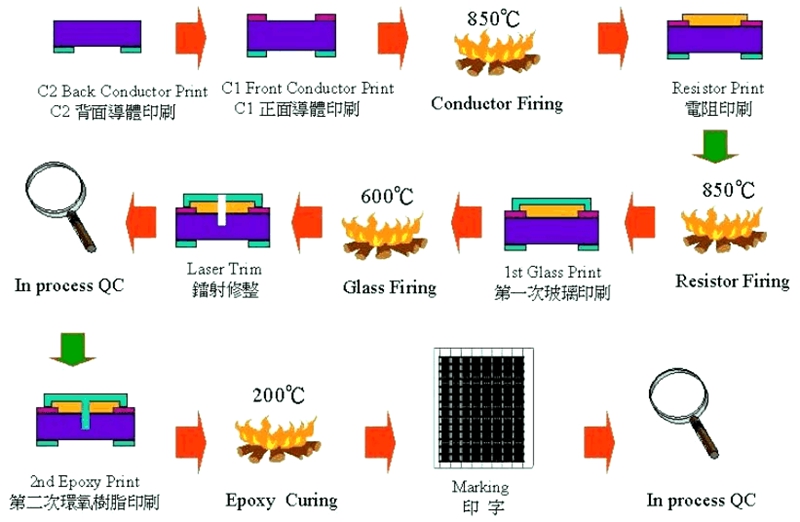Estructura de la resistencia de chip
La resistencia de chip consta de cuatro partes: el sustrato, la capa de película resistiva, el electrodo y el medio protector, y la parte del electrodo se divide en electrodo interno (plata-paladio), capa de transición (níquel), electrodos externos (principalmente estaño -estroncio).
El sustrato de la resistencia de chip es un material cerámico de alúmina de alta pureza, que tiene una resistencia mecánica y de aislamiento excepcionalmente altas, excelente conductividad térmica y resistencia a altas temperaturas; la capa de película resistiva es principalmente pasta de vidriado a base de óxido de rutenio después de altas temperaturas. Disparar lo hace; el electrodo de la capa interna es generalmente serigrafiado o sumergido, y la capa de plata resinterizada, la capa de transición y el electrodo externo son genotípicos de níquel y estaño galvanizados. La capa protectora es un esmalte de vidrio sinterizado de temperatura inusual.

Proceso de producción y proceso de resistencias de chip.
Impresión de electrodos posteriores→ Disparo→Impresión de electrodos de superficie→ Disparo→ Impresión de resistencia→ Disparo→Impresión de vidrio primario→ Disparo→Recorte láser→Impresión de vidrio secundario→ Impresión de marcas→ Disparo→Corte primario→Sellado final→ Disparo→Corte secundario → Electrodos de galvanoplastia → Prueba Clasificación → Encintado y embalaje

Problemas en la aplicación de resistencias de chip
Las resistencias SMD generalmente se producen mediante automatización a gran escala y la consistencia del producto es buena. Los problemas más comunes en los materiales entrantes no son muchos, y los siguientes problemas suelen ocurrir durante el uso:
1 El electrodo se cae: si esto sucede después de la soldadura, la razón debe analizarse desde dos aspectos: primero, la fuerza de adhesión del electrodo de la resistencia en sí no es buena y, segundo, el electrodo se quema debido a la alta temperatura durante la soldadura, especialmente durante situaciones de soldadura manual. Esta situación se verifica mediante la prueba de resistencia al calor de soldadura (260 ℃ * 10S, verificada bajo un microscopio).
2 Fractura del sustrato: Esta situación se produce principalmente por el deterioro de la resistencia por esfuerzos mecánicos externos. Por supuesto, el estrés térmico también puede causar la fractura del sustrato, pero en la práctica es raro.
3 Variación del valor de la resistencia: Generalmente, el valor de la resistencia se vuelve más prominente y falla. Esta situación se debe principalmente a una sobrecarga a largo plazo. Los circuitos utilizados en las resistencias de chip suelen tener una densidad de componentes relativamente alta y malas condiciones de disipación de calor. Al trabajar en condiciones tan duras durante mucho tiempo, se debe llevar a cabo un diseño de reducción de potencia al seleccionar resistencias para prolongar la vida útil de las resistencias de chip.
4 Oxidación del electrodo externo: esta situación afectará el efecto de soldadura de la resistencia del chip y causará fácilmente una soldadura falsa. Si el electrodo exterior está oxidado se puede juzgar desde dos aspectos. Una es observar bajo un microscopio, y se puede ver que el electrodo externo es negro; el otro es realizar una prueba de soldabilidad (235°C*3s) para mantener el estaño en el electrodo exterior (requiere que el terminal tenga un área de cobertura de soldadura superior al 90%)
Estudio de caso de falla de resistencia 1
Caso 1: Guangdong XXX Electronics Co., Ltd. Un caso de fractura de resistencia del panel principal V9636
Time: July 10, 2020
Recently in the quality control report of the production line, R407/2.2Ω resistors break on the main panel of A V9636 were found with a defect rate of 0.5% (sometimes as high as 4%). The root cause of the badness here is:
1. The V-groove between the panels of the AV9636 main panel is relatively shallow, and it isn’t easy to separate the boards. The manufacturer used too much force during the board-splitting process, breaking the resistor body
2. For the defective products brought by the engineering personnel, the relevant personnel of Gaohua confirmed that some of the semi-finished PCB boards had not been tested
Our company’s solution to the above problems is as follows:
1) Relevant personnel must inform the PCB manufacturer to change the V-groove, and IQC is responsible for confirming the effect of the change.
2) Please ask the developer to change the PCB board (AV9636-0), R408 to 2.2Ω, and R407 to a copper skin for a direct short circuit.
3) For the semi-finished PCB boards in stock (AV9636-0), after communicating with the outsourced manufacturer, we agree to return the boards that arrived before July 10, 2020, to the factory without affecting the average production of our factory Retest.
4) The outsourced manufacturer will make the corresponding sub-board tooling for the produced PCB board during production, and the outsourced manufacturer will design the tooling;
5) Personnel testing must be arranged when our production line uses the boards that arrived before July 10, 2020.
Resistor Failure Case Study 2
Case 2: Zhejiang XXX Electronic Technology Co., Ltd. VD017K game has no function case
Time: July 5, 2018
the product line produced VD017 K, and about 70% of the games on the machine had no function (sometimes no function). After analysis and testing, it was found that the decoding board R17 (6.8 kΩ /1/16W) deteriorated, resulting in low voltage. This board is a new patch, batch numbers: 2629 and 2630. Now do the following:
1. For further analysis and verification, please use another manufacturer’s 6.8kΩ / 1/16W (material number: 0090002) chip resistor 300PCS.
2. Replace R17 directly when reproducing, measure the resistance value after completion, and ask QE to verify.
3. The supply department should notify the external manufacturer to assist in the investigation of the resistor supplier, suspend the use of resistors from this manufacturer, and at the same time invite the manufacturer to come to take samples and analyze them.
4. Please ask the Type Experiment Center to test and verify all the specifications of the manufacturer’s resistors and take samples of the wrong resistors for analysis.
5. Please ask the relevant department to check the inventory of the resistors of this manufacturer and check whether there are resistors of the exact specification from other manufacturers simultaneously. If not, please immediately ask the supply department to purchase a resistor of the precise specification from other manufacturers.
After re-examination, the main reason for the failure of chip resistors is caused by poor test fixtures. There is a row of thimbles on the decoder board test frame (this row of thimbles is on the game signal output socket of the decoder board), and there is a skew phenomenon. Resistor failed.

The Chip Resistors from Risunsemi
Risunsemi recommends high-quality chip resistors to you. Click the link below to search for the chip resistors you need!

